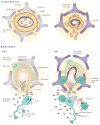Neurovascular pathways to neurodegeneration in Alzheimer's disease and other disorders
- PMID: 22048062
- PMCID: PMC4036520
- DOI: 10.1038/nrn3114
Neurovascular pathways to neurodegeneration in Alzheimer's disease and other disorders
Abstract
The neurovascular unit (NVU) comprises brain endothelial cells, pericytes or vascular smooth muscle cells, glia and neurons. The NVU controls blood-brain barrier (BBB) permeability and cerebral blood flow, and maintains the chemical composition of the neuronal 'milieu', which is required for proper functioning of neuronal circuits. Recent evidence indicates that BBB dysfunction is associated with the accumulation of several vasculotoxic and neurotoxic molecules within brain parenchyma, a reduction in cerebral blood flow, and hypoxia. Together, these vascular-derived insults might initiate and/or contribute to neuronal degeneration. This article examines mechanisms of BBB dysfunction in neurodegenerative disorders, notably Alzheimer's disease, and highlights therapeutic opportunities relating to these neurovascular deficits.
Conflict of interest statement
The author declares competing financial interests: see web version for details.
Figures







References
-
- Zlokovic BV. The blood-brain barrier in health and chronic neurodegenerative disorders. Neuron. 2008;57:178–201. - PubMed
-
- Zlokovic BV. Neurovascular mechanisms of Alzheimer’s neurodegeneration. Trends Neurosci. 2005;28:202–208. - PubMed
-
- Wu Z, et al. Role of the MEOX2 homeobox gene in neurovascular dysfunction in Alzheimer disease. Nat Med. 2005;11:959–965. Important study demonstrating that low expression of MEOX2 gene in brain endothelium leads to aberrant angiogenesis and vascular regression in Alzheimer’s disease. - PubMed
Publication types
MeSH terms
Grants and funding
LinkOut - more resources
Full Text Sources
Other Literature Sources
Medical
Molecular Biology Databases

